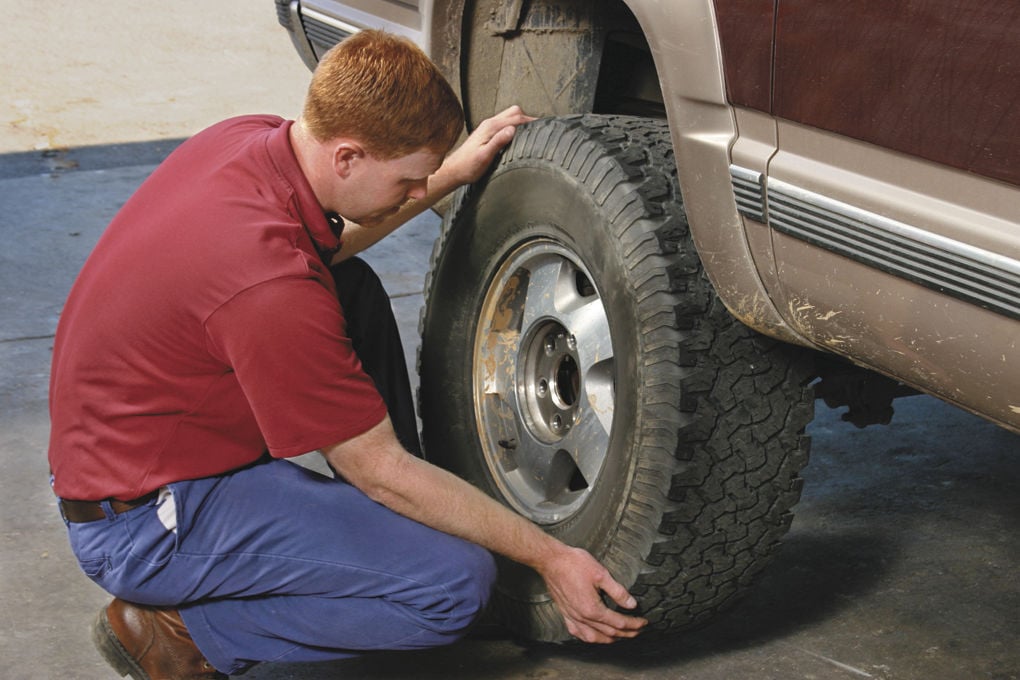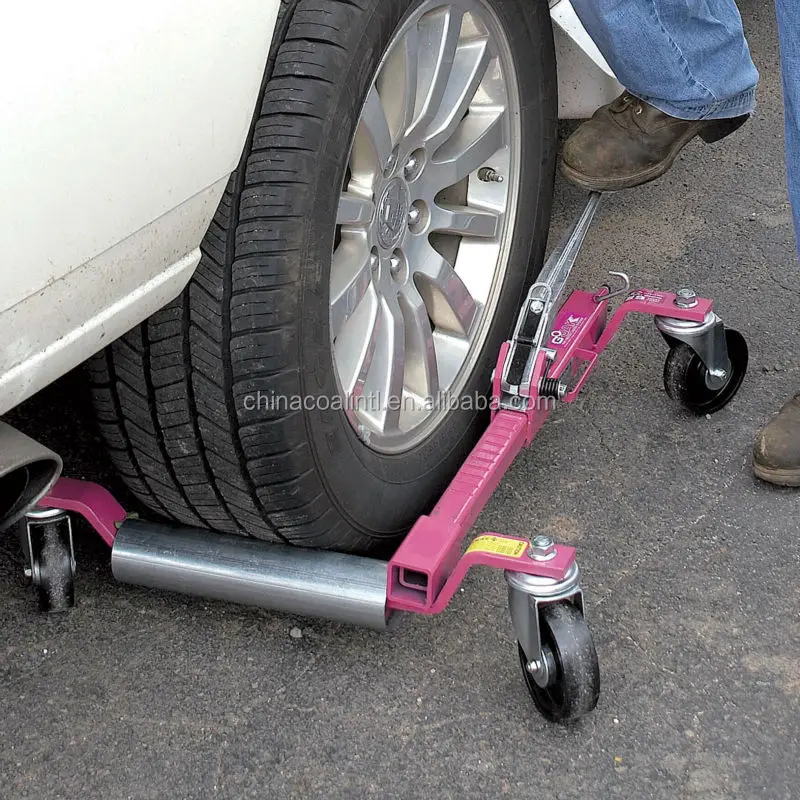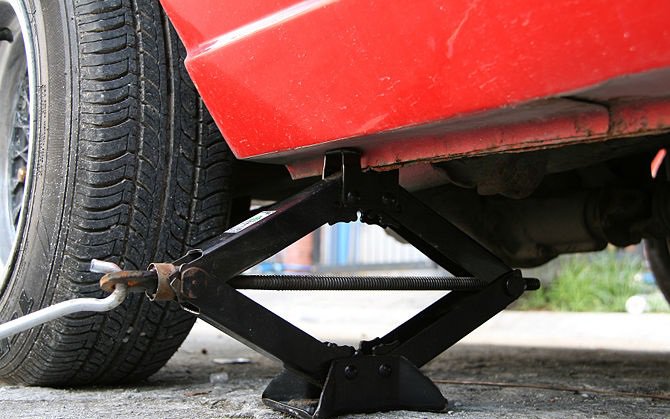When you hear that thumpa-thumpa-thumpa sound while driving down the road, you know one of your tires is flat. And that means you'll soon be changing it yourself, if you're not lucky enough to have access to roadside service for your vehicle. If the mere thought of using a car jack makes you break out in a cold sweat—and it does for many people—not to worry! Just study these three video clips and follow these six simple steps, and you'll be able to get your vehicle in the air in short order without hurting it or—more important—you.
Get off the road and as far away from traffic as you can. If you're on a highway and near an exit, take it. The goal is to get off the road entirely and on to solid, level ground—such as a parking lot—where you can use a car jack safely. Failing that, you want to find your way to a road or street with as little traffic as possible, where you can pull off to the side, away from the flow of cars, and be on a spot solid enough to support a jack.
If you're on a highway and can't get off, you'll just have to find the safest location you can; you can't drive for miles on a flat tire without destroying it and possibly damaging your vehicle. In that case, pull over to the right shoulder, as far off the road as possible. Make sure you're on a solid, level surface, so that the jack doesn't sink into the ground rather than lifting the car. A soft surface might also cause the jack to lean to one side as it's lifting the car, which can cause the car to fall.
Make sure the vehicle's engine is off, that it's in park, and that the parking brake is engaged. If you happen to have something that you can use to block a tire (a brick, a piece of wood, or a large rock will do), place it under the tire at the opposite corner of the car from the corner you're going to jack up (e.g., if you're jacking up the right front, block the left rear tire). This is further insurance that the car will not roll off the jack. If you have passengers, it's a good idea to have them exit the car, but it's not absolutely necessary.
If you have passengers, it's a good idea to have them exit the car, but it's not absolutely necessary.
In most vehicles, the jack is stored in the trunk or in an SUV's wayback, under the cargo-floor cover. After you find it, you need to locate the jacking points on the car's body, where the jack engages. The jacking points for most vehicles are reinforced metal ribs specifically designed to safely lift the vehicle. On most vehicles, there are four jacking points. They're located under the car's rocker panels, just behind the front wheels and just ahead of the rear wheels. In the above video, our Car and Driver tech is pointing to the right front jacking point on the Hyundai Sonata sedan we're about to lift. To be sure about the jacking point locations for your vehicle, check your owner's manual.
Most car jacks have a slot at the top, on their engagement flange, that slips onto the jack point's reinforced rib—but your car may have a different setup, so check your owner's manual to be sure you understand exactly how your jack works with the jacking point. In the above video, our tech needs to spin the jack down first, so it can fit under the car before he begins jacking it up.
In the above video, our tech needs to spin the jack down first, so it can fit under the car before he begins jacking it up.
Turn the jack handle clockwise slowly until the flat tire comes off the ground. Take your time and make sure that the jack remains positioned straight up and down as it lifts the car. You don't want the jack leaning, because it won't hold the car securely that way. If you're lifting the car to get under it, to do some work, or to change the oil, you must place a jack stand under the rocker panel near the jack and snug it up to the car's body. This will ensure that the car cannot fall on you, should the jack slip or fail entirely.
Getty Images
Safety note: If you're jacking up the car to work on it at home, it's a good idea to use a more robust floor jack—the kind with the long handle that you pump (pictured above). This is the type of jack used at repair shops and in the pits at car races, because it's much stronger and more stable than a car's onboard jack. A jack stand placed in the proper position is pictured below, alongside a floor jack (with its handle removed).
This is the type of jack used at repair shops and in the pits at car races, because it's much stronger and more stable than a car's onboard jack. A jack stand placed in the proper position is pictured below, alongside a floor jack (with its handle removed).
Getty Images
When you're ready to lower the car, slowly unwind the jack handle in the opposite direction (counterclockwise) until the car's tire is firmly in contact with the ground and you can remove the jack. Return the jack to its storage location, secure it, and you're almost ready to roll. But before you fire up the engine, don't forget to remove whatever you used to block a tire, or you might think the parking brake is stuck on when you try to drive off.
Now 53% Off
$140 at Amazon
Now 41% Off
$20 at Amazon
$68 at Amazon
$70 at Amazon
Rich Ceppos
Director, Buyer's Guide
Rich Ceppos has evaluated automobiles and automotive technology during a career that has encompassed 10 years at General Motors, two stints at Car and Driver totaling 19 years, and thousands of miles logged in racing cars. He was in music school when he realized what he really wanted to do in life and, somehow, it's worked out. In between his two C/D postings he served as executive editor of Automobile Magazine; was an executive vice president at Campbell Marketing & Communications; worked in GM's product-development area; and became publisher of Autoweek. He has raced continuously since college, held SCCA and IMSA pro racing licenses, and has competed in the 24 Hours of Daytona. He currently ministers to a 1999 Miata and a 1965 Corvette convertible and appreciates that none of his younger colleagues have yet uttered "Okay, Boomer" when he tells one of his stories about the crazy old days at C/D.
He was in music school when he realized what he really wanted to do in life and, somehow, it's worked out. In between his two C/D postings he served as executive editor of Automobile Magazine; was an executive vice president at Campbell Marketing & Communications; worked in GM's product-development area; and became publisher of Autoweek. He has raced continuously since college, held SCCA and IMSA pro racing licenses, and has competed in the 24 Hours of Daytona. He currently ministers to a 1999 Miata and a 1965 Corvette convertible and appreciates that none of his younger colleagues have yet uttered "Okay, Boomer" when he tells one of his stories about the crazy old days at C/D.
Home » Blog » Help and Advice » How to Jack a Car
Got a project that you need a jack for, like changing a tyre or checking your exhaust? We’ve got the information you need on how to choose the right one and how to use it safely.
There are two main types of car jacks that you can choose to use on your car at home: scissor jacks and floor jacks. While they both do the same thing (lift your car up) they’re slightly different so it’s best to think about how you’ll be using it to decide which one you want.
While they both do the same thing (lift your car up) they’re slightly different so it’s best to think about how you’ll be using it to decide which one you want.
Let’s take a closer look at these two car jacks below.
Floor Jacks:Floor jacks are the most widely used car jack and give you stability with heavy loads. They normally have four wheels so you can move it, as well as a long handle that lets the operator pump the hydraulic lift to get the car off the ground.
Floor jacks are useful if you regularly work on your car in a home garage, and are also great for lifting cars on to jack stands (which we’ll get to later). Make sure you choose a jack that’s been approved to lift the weight of your vehicle.
Scissor Jacks:Scissor jacks are small and portable, so they’re better if you’re looking for something to carry in your boot for roadside repairs. In fact, some car manufacturers supply a scissor jack with a spare wheel, so you might have one anyway.
You can buy scissor jacks that work with any car, but most of them are built especially for a particular make or model. That’s because you need to use them on specific lifting points on the car, which you can find in your owner’s manual.
Unlike floor jacks which use a hydraulic pump, scissor jacks use a simple screw mechanism to provide the lifting power. This is what makes them so small, lightweight and portable.
The jack you choose will depend on what kind of maintenance and repairs you normally carry out on your car. If you do a lot of your own maintenance work, like changing the oil filter and brake pads, we’d recommend a floor jack. If you’ll be using it for changing the wheels in an emergency, a scissor jack is an affordable choice that’s portable and easy to use.
Car jacks are easy to use once you know the basics. Here, we tell you how to use both floor and scissor jacks to lift your car safely, and how to put your car on to jack stands.
For both jack types, always make sure your car is in first gear with the handbrake on to prevent the car rolling. You can also use chocks to stop the wheels from moving, but they’re not always necessary.
Using a Floor Jack:

Jack stands are handy if you’re working under your car for long periods and need extra stability. It’s also a good idea to you use jack stands if you’re storing a classic car, as raising the car off the ground will prevent the tyres becoming warped.
Here’s how to jack your car up on to a set of jack stands.

Jacking up a car can be dangerous, so make sure you take your time, use the right equipment and find your car’s safe lifting points. Here are some extra safety tips:

From flat tyres to non-starting engines, Holts develop car repair products that are designed to get you back on the road when the worst should happen. For more information or to browse our complete product range, visit our homepage today.
Every driver, without exception, at least once in his life is faced with the need to use a jack. This wonderful device is a magic wand of salvation when changing a wheel. With it, you can easily raise the car and hold it in this position for the required amount of time. Unfortunately, driving courses do not teach beginners how to use a jack, and therefore they are forced to master such knowledge on their own.
Contents
Car jack refers to devices that have a simple design. In the past, this device was used by the Greeks in order to forcefully open the gates of the acropolises. The first hydraulic jack for a car was created by the famous inventor Lunati. Since the invention of the lifting device until today, the mechanism has been an integral part of the automotive tool kit.
The first hydraulic jack for a car was created by the famous inventor Lunati. Since the invention of the lifting device until today, the mechanism has been an integral part of the automotive tool kit.
Remember, the jack is used exclusively for lifting vehicles! To keep it at a raised height, this device alone is not enough and not enough. Do not risk your health and your life, do not climb under a car that rests solely on a jack.
The video shows how to choose the right jack:
There are several rules for the safe use of the jack, because, despite the simple design, improper use of the mechanism can be life-threatening:
 If you can't find a level surface, park near a high curb, turn your wheels towards it and block them well.
If you can't find a level surface, park near a high curb, turn your wheels towards it and block them well.  Lock them at the required height and you can safely remove the lifting device. Remember, bricks, stones and wedges do not fit the role of props at all .
Lock them at the required height and you can safely remove the lifting device. Remember, bricks, stones and wedges do not fit the role of props at all . The video shows how the hydraulic jack works:
http://www.youtube.com/watch?v=6EHI3ewe-3Y
In order to be 100% sure of your safety, it is not enough just to follow the rules for using this mechanism, you also need to choose the right one for your car. Unfortunately, how to choose a car jack is also not taught in a driving school, so many inexperienced drivers buy something completely different from what suits them, and are convinced of this only when they start using their purchase for its intended purpose.
The rules for choosing a lifting device are very simple and unpretentious:

Knowing their typical features will also help you choose a car jack. For example, for its use in the walls of the garage, it is best to buy a hydraulic bottle jack.
Depending on the principle of operation, a distinction is made between mechanical and hydraulic lifting devices. Most often, complete with a car, you get a mechanical jack. Such devices, in turn, may be lever or folding.
Such devices, in turn, may be lever or folding.
The world is slowly forgetting about levers, they are no longer produced and sold. At this time, the popularity of folding is gaining momentum. Folding models are great for lifting cars weighing less than 2 tons. Their small carrying capacity makes them convenient and easy to use, store and transport. You can also safely say that folding jacks are very reliable.
Hydraulic jacks are chosen for vehicles with a large weight and, accordingly, dimensions. Their power affects weight and cost. Distinguish rolling and telescopic. The first is better not to operate in the middle of the road. Due to their significant carrying capacity, their purpose is car services and garage repairs of minivans, minibuses and jeeps. Telescopic jacks raise the car due to the operation of the piston of the hydraulic mechanism. Hydraulic lifting devices must only be stored and transported in an upright position , otherwise the working fluid will end up on your floor or in the trunk. These jacks require special attention: you need to constantly monitor the oil level and the tightness of the seals and valves.
These jacks require special attention: you need to constantly monitor the oil level and the tightness of the seals and valves.
Choosing a car jack is not difficult if you know the characteristics of your car, decide which size and weight suits you, and decide on the amount that you are willing to spend on a future purchase.
The jack is your insurance against a tire breakdown and the need to replace it on the road. There are several types of construction of lifting mechanisms, and the rules for their operation differ significantly. While the general recommendations remain the same, knowledge , how to use the jack , lying in your trunk or standing in the corner of the garage - a guarantee of the health of your car and your safety.
Before we look at how to use a rack and pinion jack, here are some general safety rules for lifting a car:
 For automatic, make sure the "Park" position is selected;
For automatic, make sure the "Park" position is selected;
Rack jacks are similar in design to the HighJack. The main differences are the shorter length of the device and, as a result, the lifting height of the machine. Another important difference is that instead of a lever used in hijacks, the ascent and descent is controlled by a rotating handle. This design is more secure, as the double locking system of the handle ensures that it does not start to rotate unintentionally.
To lift the machine:
 If you doubt its stability, it is necessary to place a support in the form of a plank or other solid material with an area larger than the heel of the jack;
If you doubt its stability, it is necessary to place a support in the form of a plank or other solid material with an area larger than the heel of the jack;
This type of jack is the most popular among SUV drivers. The answer to the question of how to use the hijack , is almost identical to the described rules for operating rack jacks. Safety Differences:
